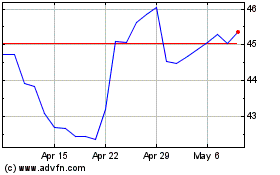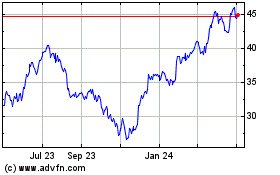GM Affirms Profit Outlook Despite Chip-Shortage Woes -- Update
May 05 2021 - 9:13AM
Dow Jones News
By Mike Colias
General Motors Co. said it expects to hit the high end of its
estimated 2021 profit range, as strong pricing and brisk
new-vehicle demand helped offset the financial impact of a vexing
chip shortage.
GM reiterated its guidance Wednesday while reporting
first-quarter net profit of $3.02 billion, up from about $300
million a year earlier, when the coronavirus pandemic disrupted
operations. The company said the semiconductor shortage will hurt
second-quarter output but that it will continue to give priority to
its most profitable vehicles, large pickup trucks and sport-utility
vehicles.
The nation's largest auto maker by sales said pretax profit
adjusted for one-time items hit $4.42 billion, equivalent to $2.25
a share. That beat the $1.05 average estimate of analysts surveyed
by FactSet.
Revenue was $32.5 billion for the first quarter, compared with
$32.7 billion a year earlier.
GM said it is confident that it will hit the high end of its
previously issued guidance of $10 billion to $11 billion for the
year, even as the impact from the semiconductor shortage cuts as
much as $2 billion from the bottom line.
Shares rose about 3% in premarket trading.
A shortage of semiconductors globally continues to bedevil the
auto industry with car companies expected to lose about 3.4 million
units of vehicle production this year due to factory stoppages
related to the lack of this critical part, according to research
firm AutoForecast Solutions LLC. The industry produced 90.7 million
vehicles during all of 2020, according to Wards Intelligence.
In North America -- by far the biggest profit generator for GM
and rival Ford Motor Co. -- GM had to cut around 340,000 vehicles
from its production plans so far this year, while Ford cut around
310,000, AutoForecast estimates.
But for Ford, the financial impact has been deeper because it
has had to reduce output for several weeks at two F-150 pickup
truck plants. The F-150 pickup truck is the company's bestseller
and its biggest moneymaker. Meanwhile, GM's key pickup-truck and
big-SUV factories have managed to sustain near-normal schedules.
Ford shares sank last week after it gave profit guidance for the
second half of the year that disappointed investors.
The auto industry's snarled output has left car makers with
historically low vehicle stocks. At the end of April in the U.S.,
there were fewer than 2 million vehicles on dealership lots or en
route to stores, 39% lower than a year earlier, according to
research firm Wards Intelligence.
Even so, new-car buyers have been showing up at dealerships in
droves as pandemic restrictions loosen, federal stimulus money
flows and interest rates remain tame. The pace of new-vehicle sales
in April hit its fastest clip in more than 15 years on a
seasonally-adjusted basis, according to JPMorgan Chase.
The ripe car-buying environment has helped shares of auto makers
remain resilient despite the supply-chain disruptions, Morgan
Stanley analyst Adam Jonas said in a research note Monday.
Investors so far have largely been looking past the chip issue, and
are drawn to the industry's strong pricing and future bets on
electric and autonomous cars, he said.
GM shares this year were up 33% through Tuesday's close while
Ford's had risen 30%.
Write to Mike Colias at Mike.Colias@wsj.com
(END) Dow Jones Newswires
May 05, 2021 08:58 ET (12:58 GMT)
Copyright (c) 2021 Dow Jones & Company, Inc.
General Motors (NYSE:GM)
Historical Stock Chart
From Aug 2024 to Sep 2024

General Motors (NYSE:GM)
Historical Stock Chart
From Sep 2023 to Sep 2024
